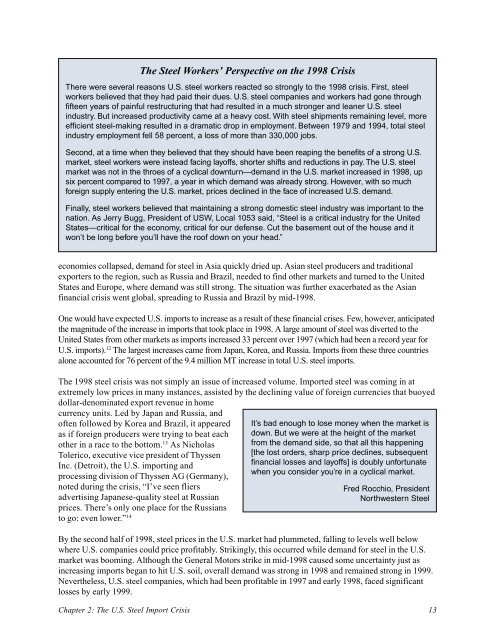Global Steel Trade; Structural Problems and Future Solutions
Global Steel Trade; Structural Problems and Future Solutions
Global Steel Trade; Structural Problems and Future Solutions
Create successful ePaper yourself
Turn your PDF publications into a flip-book with our unique Google optimized e-Paper software.
The <strong>Steel</strong> Workers’ Perspective on the 1998 Crisis<br />
There were several reasons U.S. steel workers reacted so strongly to the 1998 crisis. First, steel<br />
workers believed that they had paid their dues. U.S. steel companies <strong>and</strong> workers had gone through<br />
fifteen years of painful restructuring that had resulted in a much stronger <strong>and</strong> leaner U.S. steel<br />
industry. But increased productivity came at a heavy cost. With steel shipments remaining level, more<br />
efficient steel-making resulted in a dramatic drop in employment. Between 1979 <strong>and</strong> 1994, total steel<br />
industry employment fell 58 percent, a loss of more than 330,000 jobs.<br />
Second, at a time when they believed that they should have been reaping the benefits of a strong U.S.<br />
market, steel workers were instead facing layoffs, shorter shifts <strong>and</strong> reductions in pay. The U.S. steel<br />
market was not in the throes of a cyclical downturn—dem<strong>and</strong> in the U.S. market increased in 1998, up<br />
six percent compared to 1997, a year in which dem<strong>and</strong> was already strong. However, with so much<br />
foreign supply entering the U.S. market, prices declined in the face of increased U.S. dem<strong>and</strong>.<br />
Finally, steel workers believed that maintaining a strong domestic steel industry was important to the<br />
nation. As Jerry Bugg, President of USW, Local 1053 said, “<strong>Steel</strong> is a critical industry for the United<br />
States—critical for the economy, critical for our defense. Cut the basement out of the house <strong>and</strong> it<br />
won’t be long before you’ll have the roof down on your head.”<br />
economies collapsed, dem<strong>and</strong> for steel in Asia quickly dried up. Asian steel producers <strong>and</strong> traditional<br />
exporters to the region, such as Russia <strong>and</strong> Brazil, needed to find other markets <strong>and</strong> turned to the United<br />
States <strong>and</strong> Europe, where dem<strong>and</strong> was still strong. The situation was further exacerbated as the Asian<br />
financial crisis went global, spreading to Russia <strong>and</strong> Brazil by mid-1998.<br />
One would have expected U.S. imports to increase as a result of these financial crises. Few, however, anticipated<br />
the magnitude of the increase in imports that took place in 1998. A large amount of steel was diverted to the<br />
United States from other markets as imports increased 33 percent over 1997 (which had been a record year for<br />
U.S. imports). 12 The largest increases came from Japan, Korea, <strong>and</strong> Russia. Imports from these three countries<br />
alone accounted for 76 percent of the 9.4 million MT increase in total U.S. steel imports.<br />
The 1998 steel crisis was not simply an issue of increased volume. Imported steel was coming in at<br />
extremely low prices in many instances, assisted by the declining value of foreign currencies that buoyed<br />
dollar-denominated export revenue in home<br />
currency units. Led by Japan <strong>and</strong> Russia, <strong>and</strong><br />
often followed by Korea <strong>and</strong> Brazil, it appeared<br />
as if foreign producers were trying to beat each<br />
other in a race to the bottom. 13 As Nicholas<br />
Tolerico, executive vice president of Thyssen<br />
Inc. (Detroit), the U.S. importing <strong>and</strong><br />
processing division of Thyssen AG (Germany),<br />
noted during the crisis, “I’ve seen fliers<br />
advertising Japanese-quality steel at Russian<br />
prices. There’s only one place for the Russians<br />
to go: even lower.” 14<br />
It’s bad enough to lose money when the market is<br />
down. But we were at the height of the market<br />
from the dem<strong>and</strong> side, so that all this happening<br />
[the lost orders, sharp price declines, subsequent<br />
financial losses <strong>and</strong> layoffs] is doubly unfortunate<br />
when you consider you’re in a cyclical market.<br />
Fred Rocchio, President<br />
Northwestern <strong>Steel</strong><br />
By the second half of 1998, steel prices in the U.S. market had plummeted, falling to levels well below<br />
where U.S. companies could price profitably. Strikingly, this occurred while dem<strong>and</strong> for steel in the U.S.<br />
market was booming. Although the General Motors strike in mid-1998 caused some uncertainty just as<br />
increasing imports began to hit U.S. soil, overall dem<strong>and</strong> was strong in 1998 <strong>and</strong> remained strong in 1999.<br />
Nevertheless, U.S. steel companies, which had been profitable in 1997 <strong>and</strong> early 1998, faced significant<br />
losses by early 1999.<br />
Chapter 2: The U.S. <strong>Steel</strong> Import Crisis 13
















